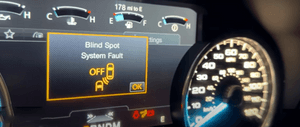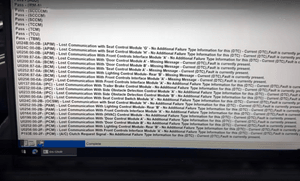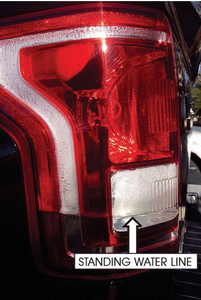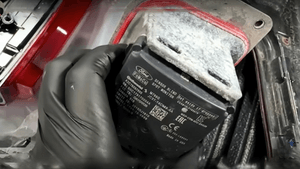Is it possible for a burned-out taillight bulb replacement to get into the four digit figure category?
Owners of 2015 and later Ford F150 trucks that were purchased with high trim options, beware what awaits you sooner than you think.
In the name of anonymity protection, we will refer to our victim as Harry. Harry is the proud owner of a 2018 Ford F150 with the Platinum trim level. This means Harry’s truck has all the bells and whistles that modern vehicle engineering has to offer.
One unsuspecting day, Harry gets into his five year old truck with 95.00 miles showing on the odometer and starts it up just as would on any other day. Except this day Harry’s instrument cluster was displaying the warning message seen below.
Harry has no idea of what a Blind Spot System Fault is, but what Harry did find out is his heating and AC system and radio were as dead as a door nail. None of the buttons responded to Harry’s touch.
At this point Harry thought it would be a good idea to visit Ford Tech Makuloco which is a Ford specialty repair shop that is owned by a Ford certified master technician.
The first step the technician took was to connect his scan tool to the truck to see what caused the dash warning message to appear. What the tech found is seen below, all systems that are on the Medium Speed CAN Network are down with a multitude of “U” codes for all those modules.
The modules that passed are on the High Speed CAN System and are not being affected but every module on the MS System has lost communications.
The Ford tech knew that the Blind Spot System uses radar detection located in the rear tail lamp assemblies, so he decided to check out those light assemblies. What he found was the left side tail lamp assembly has standing water in it as seen below.
The tech removed the tail lamp assembly and found corrosion present in the connectors that plug into the tail lamp assembly, but that’s the least of it, also located the tail lamp assembly is the radar module that allows the Blind Spot and Cross Traffic Detection System to function, it too was corroded as shown below.
Now comes the bad news for Harry…his truck is out of his 36,000 mile, 3 year bumper to bumper warranty, which means Harry is going to have to pony up for this repair bill.
Harry’s bad news does not end here, each taillight assembly has a cost of 1200.00 dollars each. The radar module is another 500.00 dollars each plus a rear wire harness for an additional 100.00 dollars, add to this the labor charge.
You may be thinking, why should I have to buy a hundred dollar wire harness, can’t you fix the connector. Well, the answer is yes and no. Each connector end repair kit will run you 98.00 dollars, so that’s 200.00 bucks for the two connector kits. It makes better sense to spend the C-Note for a brand new harness. And yes, the Ford tech did load every connector with die-electric grease to prevent this from happening to Harry again.
By the time it was all over and done Harry’s repair bill totaled 5600.00 dollars! Yes, this is not a typo, FIVE THOUSAND AND SIX HUNDRED DOLLARS The parts replaced as shown below.
Here is one last point for all you late model F150 owners, if you see condensation inside the tail lamp assemblies, and you are still under the bumper to bumper warranty, Ford will not warranty the tail lamp assemblies if there is a buildup of condensation in them.Ford states, this is normal, because the tail lamp assemblies are vented to accommodate changes in the weather. They will only warranty them if there is standing water in the assembly. Then the dealer tech takes a photo of the water level and sends it to Ford’s warranty department and then waits for them to give the green light for the no charge repair.
Now some of these Ford truck owners are drilling small holes at the base of the tail lamp lens to allow the water to drain, if you are out of warranty, great idea. If you are still under warranty DON’T DO IT! Ford states very clearly in the warranty “any modification performed to these tail lamp assemblies will void the warranty”.
So, in closing let me say, back in 2007 when the first of its kind blind spot detection system was installed into a Volvo S80, I’m pretty certain no one had any idea what road this would take.








